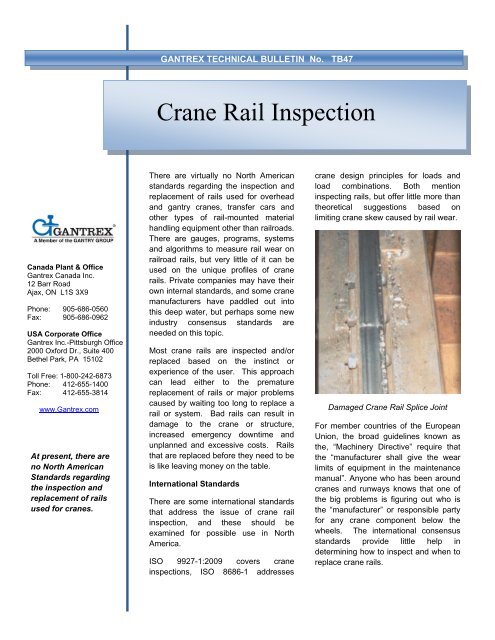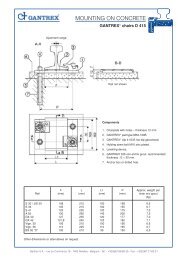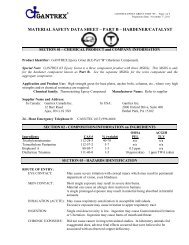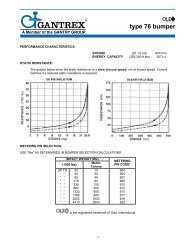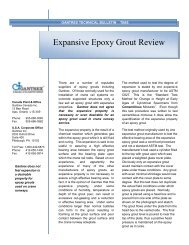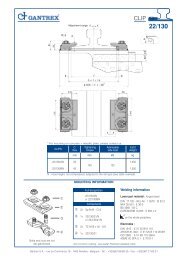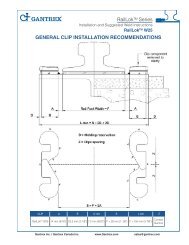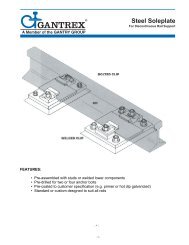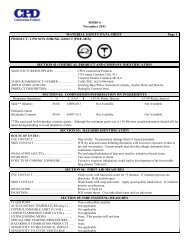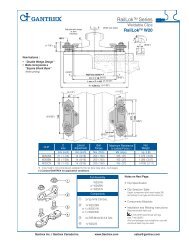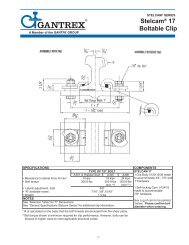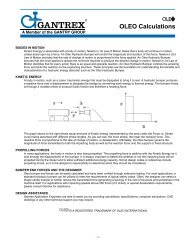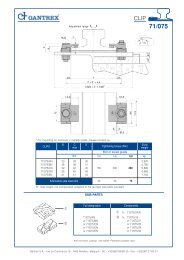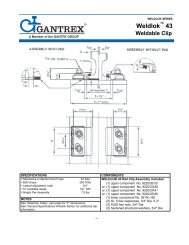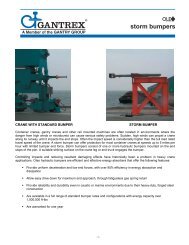Gantrex Technical Bulletin #47: Crane Rail Inspection
Gantrex Technical Bulletin #47: Crane Rail Inspection
Gantrex Technical Bulletin #47: Crane Rail Inspection
- No tags were found...
Create successful ePaper yourself
Turn your PDF publications into a flip-book with our unique Google optimized e-Paper software.
GANTREX TECHNICAL BULLETIN No. TB47<strong>Crane</strong> <strong>Rail</strong> <strong>Inspection</strong>Canada Plant & Office<strong>Gantrex</strong> Canada Inc.12 Barr RoadAjax, ON L1S 3X9Phone: 905-686-0560Fax: 905-686-0962USA Corporate Office<strong>Gantrex</strong> Inc.-Pittsburgh Office2000 Oxford Dr., Suite 400Bethel Park, PA 15102Toll Free: 1-800-242-6873Phone: 412-655-1400Fax: 412-655-3814www.<strong>Gantrex</strong>.comAt present, there areno North AmericanStandards regardingthe inspection andreplacement of railsused for cranes.There are virtually no North Americanstandards regarding the inspection andreplacement of rails used for overheadand gantry cranes, transfer cars andother types of rail-mounted materialhandling equipment other than railroads.There are gauges, programs, systemsand algorithms to measure rail wear onrailroad rails, but very little of it can beused on the unique profiles of cranerails. Private companies may have theirown internal standards, and some cranemanufacturers have paddled out intothis deep water, but perhaps some newindustry consensus standards areneeded on this topic.Most crane rails are inspected and/orreplaced based on the instinct orexperience of the user. This approachcan lead either to the prematurereplacement of rails or major problemscaused by waiting too long to replace arail or system. Bad rails can result indamage to the crane or structure,increased emergency downtime andunplanned and excessive costs. <strong>Rail</strong>sthat are replaced before they need to beis like leaving money on the table.International StandardsThere are some international standardsthat address the issue of crane railinspection, and these should beexamined for possible use in NorthAmerica.ISO 9927-1:2009 covers craneinspections, ISO 8686-1 addressescrane design principles for loads andload combinations. Both mentioninspecting rails, but offer little more thantheoretical suggestions based onlimiting crane skew caused by rail wear.Damaged <strong>Crane</strong> <strong>Rail</strong> Splice JointFor member countries of the EuropeanUnion, the broad guidelines known asthe, “Machinery Directive” require thatthe “manufacturer shall give the wearlimits of equipment in the maintenancemanual”. Anyone who has been aroundcranes and runways knows that one ofthe big problems is figuring out who isthe “manufacturer” or responsible partyfor any crane component below thewheels. The international consensusstandards provide little help indetermining how to inspect and when toreplace crane rails.
GANTREX TECHNICAL BULLETIN No. TB47 <strong>Crane</strong> <strong>Rail</strong> <strong>Inspection</strong> PAGE 2 OF 3FRA StudyThere is also a 1998 report, publishedby the United States Department ofTransportation, via the Federal <strong>Rail</strong>wayAdministration titled, “Estimation of <strong>Rail</strong>Wear Limits Based on <strong>Rail</strong> StrengthLimitations”. This report considers thefracture strength of rails, but pertainsmostly to heavy railroad rail.These numbers were derived based onanalytical tests conducted on heavy railsections that are typically used asrailroad rails. The summary of this 1998document concludes that rail should bereplaced after an allowable wear of 0.5inches of head loss or 0.6 inches of faceloss. The entire report can be viewed atthe following government web site:www.fra.dot.gov .Whiting <strong>Crane</strong> HandbookThe Whiting <strong>Crane</strong> Handbook is a greatresource for information on overheadand gantry cranes. It also containssome general guidelines as to runwaymaintenance and repair, but offers littleguidance with specific rail issues. Alltoo often, a rail is not replaced until therail sweep or end truck bottoms out, andthese repairs must be done on a costlyemergency basis.AIST EffortsOne group that is currently working onthe issue of rail inspections with twoongoing projects is the Association forIron & Steel Technology, (AIST). The<strong>Crane</strong>s Technology Committee (CTC) ofAIST are the producers of <strong>Technical</strong>Report #6 for the design of overheadcranes and <strong>Technical</strong> Report #13, whichcovers mill buildings, including cranerunways. CTC sponsored a recentsurvey of crane users to determine railinspection practices and criteria. Theresults of the study confirmed that themethods of inspection and replacementcriteria are varied by crane user and noreal or replacement criteria exist. Thesurvey also confirmed that the mostprudent crane users inspect their railsand runways at least once per year,along with the crane annual inspection.<strong>Rail</strong> splice joints are given particularattention, since they are often thesource of many rail problems, leading todamage to the overall rail system and tothe crane itself. Misalignment of thecrane wheels and/or rails will also oftencreate readily observable problems, butby this time, it is often too late to repairany one component and can be solvedonly replacing rails or wheels.The survey also indicated that manyusers find information from the <strong>Crane</strong>Manufacturers Association of America,(CMAA) to be helpful in terms of runwayalignment tolerances. (In particular, seethe “Maximum Runway Tolerances”chart in Specification #70.) The mostsignificant conclusion derived from theAIST survey and research is that thereshould be a limit to the amount of railwear, after which replacement should beconsidered before severe problemsarise.The follow-on effort to the survey by theAIST committee is the development ofan extensive new technical report with aworking title of “<strong>Crane</strong> <strong>Inspection</strong>,Maintenance and Repair Guidelines”.The intent of this document is todescribe methods of inspection andreplacement criteria for all aspects ofoverhead cranes, and it will include asignificant section on rails and runways.This new technical report could beavailable as early as 2013 from AIST.
PAGE 3 of 3 GANTREX TECHNICAL BULLETIN No. TB47 <strong>Crane</strong> <strong>Rail</strong> <strong>Inspection</strong>Absent any otherreplacement criteria,the 25% rule shouldbe used as a worstcase scenario.rail when it was new. This can be doneby referencing specification sheets forthe given rail size, or by simplymeasuring the rail at a point, such asthe very ends that see little or no cranetravel.<strong>Rail</strong> wear gauge, butonly for railroad rails.Contact <strong>Gantrex</strong> at:1-800-242-6873 orwww.<strong>Gantrex</strong>.com<strong>Rail</strong> Wear TypesThe two most common types of railwear are plastic deformation and edgewear. Each will occur in every crane railapplication, the severity of whichdepends on the loading and duty cycleof a particular runway. Both types ofwear actually displace or remove metalfrom the rail surface. The results of thiswear over a long period of time canweaken the rails to the point that furtherdamage may occur, leading to failure.Obvious Signs of <strong>Crane</strong> <strong>Rail</strong> FailureThere are several failures of crane railthat can be easily identified by a visualinspection of the rail. These includebreaks in the rail, cracks in the rail headand propagating cracks from splice boltholes.Other obvious signs include theaforementioned bottoming of railsweeps and end trucks caused bysevere wear of the rail over long periodsof use. By the time these conditions arediscovered, the cost and downtime ofemergency repairs is high, and a bettermethod to determine when a rail shouldbe changed is needed.Perhaps the simplest way to determinethe amount of wear on a crane rail is tomeasure the dimensions of the rail andcompare them to the dimensions of theThe 25% RuleOne possible method to determine theamount of allowable rail wear is basedon the wheel load charts found in theWhiting <strong>Crane</strong> Handbook. It can bederived that if a given rail loses 25% ofits overall mass, the rail selection woulddrop one complete rail size category,based solely on the mass of the smallerrail as it pertains to the wheel load. Saidin another way, if a rail is worn to theextent that 25% of its mass is hasdisappeared, the wheel load wouldexceed the amount listed for that railsize. While this is a basic principle, itcan serve as a ‘lower limit’ of rail fitnessfor duty. Actual values may vary, basedon the completion of the research, butone large crane manufacturer alreadyuses this criteria when training craneinspectors regarding rail inspection.From a practical view, the point at whicha given heavy rail should be replaced ismost likely well before an aggregateloss of material. According to the FRAstudy, a 0.5” loss of head dimensionalone would account for 25% of the railmass alone. Absent any obviouscracking or damage, the 25% rule couldbe used as a maximum amount ofallowable rail wear.ConclusionFurther study to determine moreexacting values of replacement shouldbe considered by the various technicalcommittees responsible for crane, railand runway design. END.Rev 0 = 4/24/12


